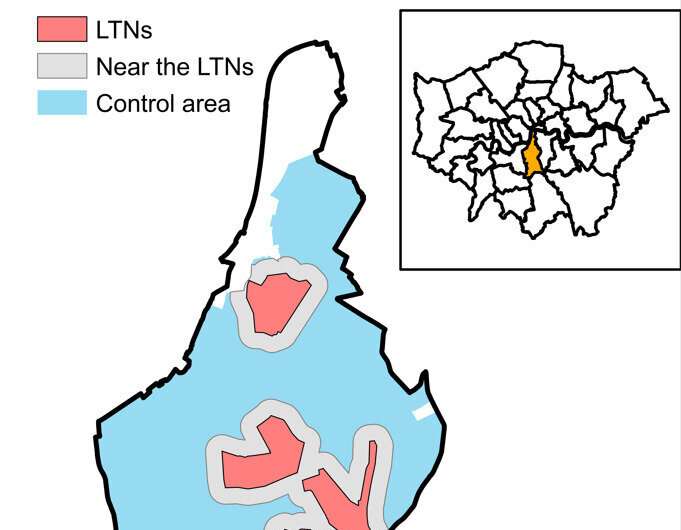This article has been reviewed according to Science X's editorial process and policies. Editors have highlighted the following attributes while ensuring the content's credibility:
fact-checked
trusted source
proofread
Study: Low-traffic neighborhoods in London borough cut daily driving among residents by 1.3 km

Residents in the London Borough of Lambeth started driving less once their area became a low traffic neighborhood (LTN) relative to those living in surrounding areas, according to a new study.
Annual driving by residents living in four new LTNs introduced in 2020 decreased by 6% in the two years since their introduction compared to other control areas in the Borough. This equates to each driver cutting the distance they drove by around 1.3km a day, relative to drivers in control areas.
Low traffic neighborhoods aim to reduce motor traffic in residential areas by closing off side roads to cars, while still allowing pedestrians and bicycles to move freely.
LTNs seek to reduce car use, by making driving less convenient and simultaneously making walking and cycling more appealing. However, some critics have warned that LTNs could have the opposite effect—increasing total car use by forcing drivers to use less direct routes for some trips.
The study, published in the journal Findings, are evidence that LTNs can be effective at reducing driving levels in inner-city areas, with potential public health benefits including cutting road danger, air pollution and noise.
In the current study, researchers from the London School of Hygiene & Tropical Medicine (LSHTM), University of Westminster and Imperial College London, used annual data on vehicle mileage to examine the impact of introducing four new LTNs in 2020 on car and van travel by residents in the London Borough of Lambeth.
Focusing on areas covered by controlled parking zones, the team linked data on active resident parking permits for all cars or vans, with mileage data from annual MOT tests, to determine total past-year driving distance between 2018 and 2020. They then compared this to equivalent data between 2021 and 2023, following the introduction of the new LTNs. As a control, the same comparison was made in non-LTN regions at least 200 meters away.
Overall, the team found that total past-year mileage of people living inside the new LTNs decreased by 6.4% compared to those living in other regions in Lambeth during this time (equivalent to a daily decrease of 1.3 km per vehicle). They emphasize that this difference was not just a continuation of a pre-existing trend as there was no difference in trend between areas inside the LTNs and control areas in the years leading up to their introduction.
A similar decrease in mileage was seen in households which had the same vehicle registered at the same address both in 2020 and 2023. The team conclude from this that the observed decrease in driving inside the LTNs was also not simply due to people who drive a lot moving house out of LTNs, or people who don't drive much moving in. Rather, they say it indicates that existing residents were changing their behavior and starting to drive less. Observed changes in driving patterns were also not influenced by an area's wealth, with similar trends seen in more deprived and more affluent areas.
Although LTNs decreased total mileage, they did not change car or van ownership, with LTN and control areas seeing similar trends in the numbers of resident permits issued.
The authors note that the 6% reduction relates to total past-year driving, including trips that are less likely to be affected by the Lambeth LTNs, such as long inter-city trips or travel outside London. For shorter and more local trips the relative reduction in driving may be more than 6%.
Anna Goodman, lead author and Assistant Professor at LSHTM, said, "To achieve an estimated 6% relative decrease in total annual driving is really impressive. Moreover, for shorter and more local trips it is plausible that the relative decrease in residents' driving is even greater than 6%. This matters because, while reducing driving of any type is good news in terms of carbon emissions, reducing driving within cities brings large additional health benefits in terms of air pollution, noise, and road safety."
Rachel Aldred, co-author and Director of the University of Westminster's Active Travel Academy, added, "This research adds to evidence that LTNs can contribute to a shift away from driving cars. Like other important measures such as bus priority schemes, main road cycle tracks, and low emission zones, LTNs can help cities reduce harmful effects associated with using cars, which disproportionately impact those who do not own cars."
More information: Anna Goodman et al, The Impact of 2020 Low Traffic Neighbourhoods on Levels of Car/Van Driving among Residents: Findings from Lambeth, London, UK, Findings (2023). DOI: 10.32866/001c.75470
Provided by London School of Hygiene & Tropical Medicine





















